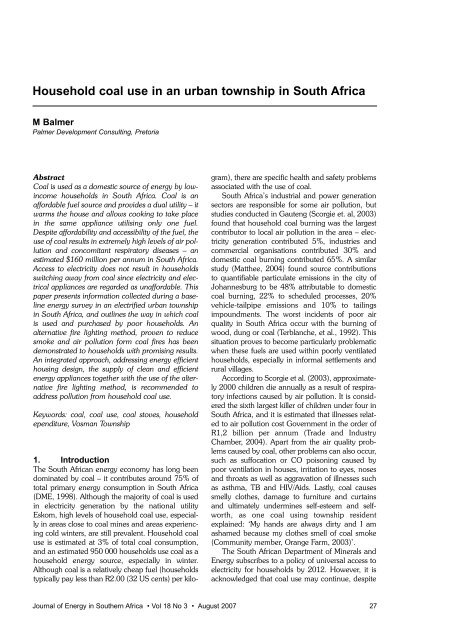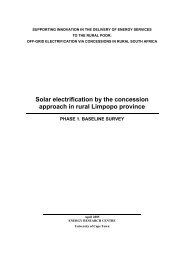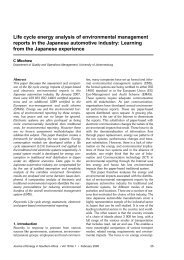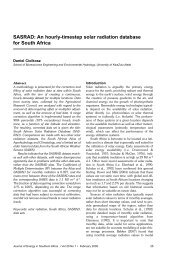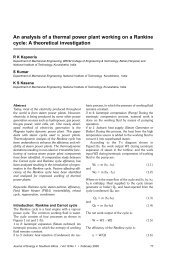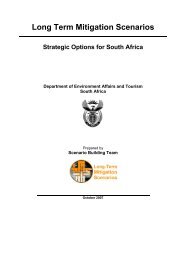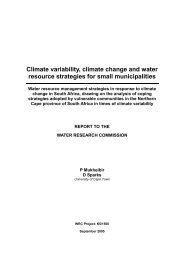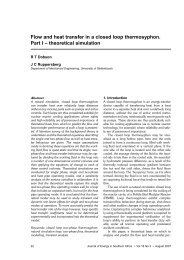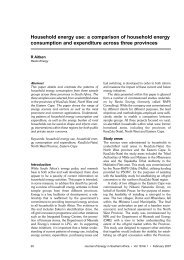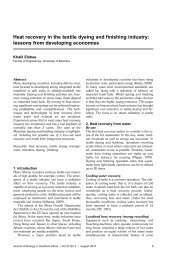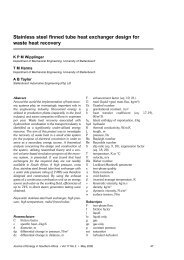Household coal use in an urban township in South Africa - NPC Online
Household coal use in an urban township in South Africa - NPC Online
Household coal use in an urban township in South Africa - NPC Online
Create successful ePaper yourself
Turn your PDF publications into a flip-book with our unique Google optimized e-Paper software.
<strong>Ho<strong>use</strong>hold</strong> <strong>coal</strong> <strong>use</strong> <strong>in</strong> <strong>an</strong> urb<strong>an</strong> <strong>township</strong> <strong>in</strong> <strong>South</strong> <strong>Africa</strong>M BalmerPalmer Development Consult<strong>in</strong>g, PretoriaAbstractCoal is <strong>use</strong>d as a domestic source of energy by low<strong>in</strong>comeho<strong>use</strong>holds <strong>in</strong> <strong>South</strong> <strong>Africa</strong>. Coal is <strong>an</strong>affordable fuel source <strong>an</strong>d provides a dual utility – itwarms the ho<strong>use</strong> <strong>an</strong>d allows cook<strong>in</strong>g to take place<strong>in</strong> the same appli<strong>an</strong>ce utilis<strong>in</strong>g only one fuel.Despite affordability <strong>an</strong>d accessibility of the fuel, the<strong>use</strong> of <strong>coal</strong> results <strong>in</strong> extremely high levels of air pollution<strong>an</strong>d concomit<strong>an</strong>t respiratory diseases – <strong>an</strong>estimated $160 million per <strong>an</strong>num <strong>in</strong> <strong>South</strong> <strong>Africa</strong>.Access to electricity does not result <strong>in</strong> ho<strong>use</strong>holdsswitch<strong>in</strong>g away from <strong>coal</strong> s<strong>in</strong>ce electricity <strong>an</strong>d electricalappli<strong>an</strong>ces are regarded as unaffordable. Thispaper presents <strong>in</strong>formation collected dur<strong>in</strong>g a basel<strong>in</strong>eenergy survey <strong>in</strong> <strong>an</strong> electrified urb<strong>an</strong> <strong>township</strong><strong>in</strong> <strong>South</strong> <strong>Africa</strong>, <strong>an</strong>d outl<strong>in</strong>es the way <strong>in</strong> which <strong>coal</strong>is <strong>use</strong>d <strong>an</strong>d purchased by poor ho<strong>use</strong>holds. Analternative fire light<strong>in</strong>g method, proven to reducesmoke <strong>an</strong>d air pollution form <strong>coal</strong> fires has beendemonstrated to ho<strong>use</strong>holds with promis<strong>in</strong>g results.An <strong>in</strong>tegrated approach, address<strong>in</strong>g energy efficienthous<strong>in</strong>g design, the supply of cle<strong>an</strong> <strong>an</strong>d efficientenergy appli<strong>an</strong>ces together with the <strong>use</strong> of the alternativefire light<strong>in</strong>g method, is recommended toaddress pollution from ho<strong>use</strong>hold <strong>coal</strong> <strong>use</strong>.Keywords: <strong>coal</strong>, <strong>coal</strong> <strong>use</strong>, <strong>coal</strong> stoves, ho<strong>use</strong>holdependiture, Vosm<strong>an</strong> Township1. IntroductionThe <strong>South</strong> Afric<strong>an</strong> energy economy has long beendom<strong>in</strong>ated by <strong>coal</strong> – it contributes around 75% oftotal primary energy consumption <strong>in</strong> <strong>South</strong> <strong>Africa</strong>(DME, 1998). Although the majority of <strong>coal</strong> is <strong>use</strong>d<strong>in</strong> electricity generation by the national utilityEskom, high levels of ho<strong>use</strong>hold <strong>coal</strong> <strong>use</strong>, especially<strong>in</strong> areas close to <strong>coal</strong> m<strong>in</strong>es <strong>an</strong>d areas experienc<strong>in</strong>gcold w<strong>in</strong>ters, are still prevalent. <strong>Ho<strong>use</strong>hold</strong> <strong>coal</strong><strong>use</strong> is estimated at 3% of total <strong>coal</strong> consumption,<strong>an</strong>d <strong>an</strong> estimated 950 000 ho<strong>use</strong>holds <strong>use</strong> <strong>coal</strong> as aho<strong>use</strong>hold energy source, especially <strong>in</strong> w<strong>in</strong>ter.Although <strong>coal</strong> is a relatively cheap fuel (ho<strong>use</strong>holdstypically pay less th<strong>an</strong> R2.00 (32 US cents) per kilogram),there are specific health <strong>an</strong>d safety problemsassociated with the <strong>use</strong> of <strong>coal</strong>.<strong>South</strong> <strong>Africa</strong>’s <strong>in</strong>dustrial <strong>an</strong>d power generationsectors are responsible for some air pollution, butstudies conducted <strong>in</strong> Gauteng (Scorgie et. al, 2003)found that ho<strong>use</strong>hold <strong>coal</strong> burn<strong>in</strong>g was the largestcontributor to local air pollution <strong>in</strong> the area – electricitygeneration contributed 5%, <strong>in</strong>dustries <strong>an</strong>dcommercial org<strong>an</strong>isations contributed 30% <strong>an</strong>ddomestic <strong>coal</strong> burn<strong>in</strong>g contributed 65%. A similarstudy (Matthee, 2004) found source contributionsto qu<strong>an</strong>tifiable particulate emissions <strong>in</strong> the city ofJoh<strong>an</strong>nesburg to be 48% attributable to domestic<strong>coal</strong> burn<strong>in</strong>g, 22% to scheduled processes, 20%vehicle-tailpipe emissions <strong>an</strong>d 10% to tail<strong>in</strong>gsimpoundments. The worst <strong>in</strong>cidents of poor airquality <strong>in</strong> <strong>South</strong> <strong>Africa</strong> occur with the burn<strong>in</strong>g ofwood, dung or <strong>coal</strong> (Terbl<strong>an</strong>che, et al., 1992). Thissituation proves to become particularly problematicwhen these fuels are <strong>use</strong>d with<strong>in</strong> poorly ventilatedho<strong>use</strong>holds, especially <strong>in</strong> <strong>in</strong>formal settlements <strong>an</strong>drural villages.Accord<strong>in</strong>g to Scorgie et al. (2003), approximately2000 children die <strong>an</strong>nually as a result of respiratory<strong>in</strong>fections ca<strong>use</strong>d by air pollution. It is consideredthe sixth largest killer of children under four <strong>in</strong><strong>South</strong> <strong>Africa</strong>, <strong>an</strong>d it is estimated that illnesses relatedto air pollution cost Government <strong>in</strong> the order ofR1,2 billion per <strong>an</strong>num (Trade <strong>an</strong>d IndustryChamber, 2004). Apart from the air quality problemsca<strong>use</strong>d by <strong>coal</strong>, other problems c<strong>an</strong> also occur,such as suffocation or CO poison<strong>in</strong>g ca<strong>use</strong>d bypoor ventilation <strong>in</strong> ho<strong>use</strong>s, irritation to eyes, noses<strong>an</strong>d throats as well as aggravation of illnesses suchas asthma, TB <strong>an</strong>d HIV/Aids. Lastly, <strong>coal</strong> ca<strong>use</strong>ssmelly clothes, damage to furniture <strong>an</strong>d curta<strong>in</strong>s<strong>an</strong>d ultimately underm<strong>in</strong>es self-esteem <strong>an</strong>d selfworth,as one <strong>coal</strong> us<strong>in</strong>g <strong>township</strong> residentexpla<strong>in</strong>ed: ‘My h<strong>an</strong>ds are always dirty <strong>an</strong>d I amashamed beca<strong>use</strong> my clothes smell of <strong>coal</strong> smoke(Community member, Or<strong>an</strong>ge Farm, 2003)’.The <strong>South</strong> Afric<strong>an</strong> Department of M<strong>in</strong>erals <strong>an</strong>dEnergy subscribes to a policy of universal access toelectricity for ho<strong>use</strong>holds by 2012. However, it isacknowledged that <strong>coal</strong> <strong>use</strong> may cont<strong>in</strong>ue, despiteJournal of Energy <strong>in</strong> <strong>South</strong>ern <strong>Africa</strong> • Vol 18 No 3 • August 2007 27
ho<strong>use</strong>holds hav<strong>in</strong>g access to electricity: ‘Researchhas shown that electrified low-<strong>in</strong>come ho<strong>use</strong>holdscont<strong>in</strong>ue to <strong>use</strong> a r<strong>an</strong>ge of fuels beca<strong>use</strong> electricityis found to be less cost effective (Department ofM<strong>in</strong>erals <strong>an</strong>d Energy, 1998)’. It is, however, notonly the low cost of the fuel that makes <strong>coal</strong> attractivefor low-<strong>in</strong>come ho<strong>use</strong>holds. Coal providesthermal energy for space heat<strong>in</strong>g <strong>an</strong>d cook<strong>in</strong>gsimult<strong>an</strong>eously, kill<strong>in</strong>g two birds with one stone, soto speak – one fuel <strong>an</strong>d one appli<strong>an</strong>ce providesenergy for two end-<strong>use</strong>s. It is beca<strong>use</strong> of this dualutility that other energy forms f<strong>in</strong>d it difficult tocompete with <strong>coal</strong>.Coal is burned <strong>in</strong> a variety of stoves (bought <strong>an</strong>dhome-made) as well as home-made imbhawulas,t<strong>in</strong> drums punched full of holes <strong>an</strong>d <strong>use</strong>d as a brazier,illustrated below.2. BackgroundThe data presented <strong>in</strong> this paper was collected dur<strong>in</strong>ga project sponsored by Anglo Coal <strong>in</strong> the <strong>in</strong>terestof community development <strong>an</strong>d social <strong>in</strong>vestment<strong>in</strong> the Vosm<strong>an</strong> Township near Witb<strong>an</strong>k <strong>in</strong> theMpumal<strong>an</strong>ga prov<strong>in</strong>ce of <strong>South</strong> <strong>Africa</strong>. Anglo Coalappo<strong>in</strong>ted PDC, a private research <strong>an</strong>d consult<strong>in</strong>gfirm, to implement a project aimed at demonstrat<strong>in</strong>g<strong>an</strong>d popularis<strong>in</strong>g the Basa njengo Magogo alternativefire light<strong>in</strong>g method to 10 000 ho<strong>use</strong>holds.The data presented <strong>in</strong> the paper was mostly collecteddur<strong>in</strong>g the basel<strong>in</strong>e study of the broader programme.Data collection was effected through a questionnaire-based<strong>in</strong>terview conducted with the ho<strong>use</strong>holdmember responsible for procur<strong>in</strong>g ho<strong>use</strong>holdenergy <strong>an</strong>d specifically <strong>coal</strong>. <strong>Ho<strong>use</strong>hold</strong>s were r<strong>an</strong>domlyselected from the three Wards <strong>in</strong> the projectarea. In total, 142 <strong>in</strong>terviews were conducted. Ofthe total 142 <strong>in</strong>terviews conducted, 76 were conductedwith female respondents, while 36 were conductedwith male respondents. The high number offemale respondents confirms the traditional positionof women as the procurers <strong>an</strong>d m<strong>an</strong>agers of ho<strong>use</strong>holdenergy.The <strong>township</strong> c<strong>an</strong> be described as a fairly typicalexample of <strong>an</strong> urb<strong>an</strong> <strong>township</strong> <strong>in</strong> <strong>South</strong> <strong>Africa</strong>.Sections of the <strong>township</strong> had been electrifiedaround 3 years ago, <strong>an</strong>d general service provisionimproved with the <strong>in</strong>stallation of water reticulation<strong>an</strong>d water borne sewage. However, m<strong>an</strong>y challengesrema<strong>in</strong> – roads are un-tarred, <strong>in</strong>formal ho<strong>use</strong>sjostle for space with formal ho<strong>use</strong>s, no system forref<strong>use</strong> removal is <strong>in</strong> place <strong>an</strong>d health services arelack<strong>in</strong>g. Ho<strong>use</strong>s are built from a variety of materials<strong>in</strong>clud<strong>in</strong>g highly energy-<strong>in</strong>efficient material such asz<strong>in</strong>c, illustrated below.Figure 1: Imbhawulas <strong>in</strong> Vosm<strong>an</strong>Commercially purchased <strong>coal</strong> stoves are oftenprized possessions <strong>an</strong>d passed on to other familymembers, effectively ensur<strong>in</strong>g that old <strong>coal</strong> stovesare never discarded, but also ensur<strong>in</strong>g that smoky,badly ventilated stoves with broken chimneys stay<strong>in</strong> <strong>use</strong> <strong>an</strong>d contribute to the problems associatedwith <strong>coal</strong> <strong>use</strong>.The paper will outl<strong>in</strong>e some f<strong>in</strong>d<strong>in</strong>gs around<strong>coal</strong> <strong>use</strong> <strong>in</strong> a low-<strong>in</strong>come, electrified <strong>township</strong> of<strong>South</strong> <strong>Africa</strong>. The f<strong>in</strong>d<strong>in</strong>gs will also touch on them<strong>an</strong>ner <strong>in</strong> which ho<strong>use</strong>holds acquire <strong>coal</strong> <strong>in</strong> the<strong>township</strong>, describ<strong>in</strong>g a unique situation where <strong>coal</strong>is collected from a nearby ab<strong>an</strong>doned m<strong>in</strong>e dump.Lastly, the paper will discuss potential solutions tomake the <strong>in</strong>evitable <strong>use</strong> of <strong>coal</strong> safer <strong>an</strong>d less harmfulto <strong>in</strong>dividuals <strong>an</strong>d the environment.Figure 2: A z<strong>in</strong>c ho<strong>use</strong> <strong>in</strong> Ward 7, Vosm<strong>an</strong>TownshipThe ho<strong>use</strong>s are not <strong>in</strong>sulated <strong>an</strong>d only rarelyhave ceil<strong>in</strong>gs. Indoor temperatures c<strong>an</strong> be as muchas 5 degrees lower th<strong>an</strong> the outside temperaturedur<strong>in</strong>g w<strong>in</strong>ter, necessitat<strong>in</strong>g a large amount of fuelto make it remotely comfortable <strong>in</strong>side the ho<strong>use</strong>.28 Journal of Energy <strong>in</strong> <strong>South</strong>ern <strong>Africa</strong> • Vol 18 No 3 • August 2007
Coal is often the fuel of choice beca<strong>use</strong> of its availability,affordability <strong>an</strong>d dual utility as discussedabove.The average ho<strong>use</strong>hold <strong>in</strong> the project area wasfound to consist of 5 people, with the highest numberof people per ho<strong>use</strong>hold reported be<strong>in</strong>g 13, <strong>an</strong>dthe lowest 1. This is higher th<strong>an</strong> the 2001 reportednational ho<strong>use</strong>hold size of 3.8 for <strong>South</strong> <strong>Africa</strong>(www.<strong>in</strong>fo.gov.za/aboutsa).Almost 50% of the sample reported ho<strong>use</strong>holdearn<strong>in</strong>gs of less th<strong>an</strong> R500 per month <strong>an</strong>d <strong>in</strong> total,81% of the sample earned below R1500 permonth. Although ho<strong>use</strong>hold <strong>in</strong>come levels werefound to be low, most ho<strong>use</strong>holds <strong>in</strong> the samplegenerated some form of <strong>in</strong>come, either throughemployment or micro enterprises <strong>an</strong>d even farm<strong>in</strong>gactivities. In total, 58% of the sample ga<strong>in</strong>ed <strong>an</strong><strong>in</strong>come through employment or self-employment,while only 29% of the sample relied on welfare orpension payments <strong>an</strong>d remitt<strong>an</strong>ces as a ho<strong>use</strong>hold<strong>in</strong>come. Only 13% of the sample reported be<strong>in</strong>gunemployed.3. Coal <strong>use</strong> <strong>an</strong>d ho<strong>use</strong>hold expenditureon <strong>coal</strong>By far the majority of the ho<strong>use</strong>holds <strong>in</strong> the Vosm<strong>an</strong>sample (92%) reported us<strong>in</strong>g <strong>coal</strong> as a ho<strong>use</strong>holdfuel, <strong>an</strong>d only 11 (8%) ho<strong>use</strong>holds reported notus<strong>in</strong>g <strong>coal</strong> at all, as illustrated below.Research further <strong>in</strong>dicated that low-<strong>in</strong>comeho<strong>use</strong>holds clearly do not ab<strong>an</strong>don the <strong>use</strong> of otherfuels once they are connected to the electricity grid,<strong>an</strong>d that the <strong>use</strong> of fuels such as <strong>coal</strong>, paraff<strong>in</strong>,wood <strong>an</strong>d gas cont<strong>in</strong>ues despite hav<strong>in</strong>g access toelectricity for a signific<strong>an</strong>t period of time. For example,Market Support Associates (2003) concludedthat ‘even <strong>in</strong> electrified ho<strong>use</strong>holds, electricity isonly the fourth most <strong>use</strong>d form of cook<strong>in</strong>g energy.Furthermore the presence or absence of electricityhas less effect on fuel choice th<strong>an</strong> other demographics,particularly affluence or age’. Recentresearch carried out by Lloyd et al. (2004) <strong>in</strong> theCape Town <strong>township</strong> of Khayelitsha, however,pa<strong>in</strong>ts a slightly more positive picture. Lloyd et al(2004) found that among ho<strong>use</strong>holds with a regularmetered supply of electricity, 68% <strong>use</strong> <strong>an</strong> electricstove as their ma<strong>in</strong> source of cook<strong>in</strong>g appli<strong>an</strong>ce,while 53% of ho<strong>use</strong>holds with electricity from <strong>an</strong>extension cord connection <strong>use</strong> <strong>an</strong> electric stove –the rema<strong>in</strong>der <strong>use</strong>d paraff<strong>in</strong> stoves. Based on theresearch, Lloyd et al. (2004) concluded that ho<strong>use</strong>holdsare progress<strong>in</strong>g well towards a total tr<strong>an</strong>sitionto electricity but that this may only be true for thespecific area, s<strong>in</strong>ce broader regional data still <strong>in</strong>dicatesa slow uptake of electricity for thermal <strong>use</strong>s.Therefore, despite progress be<strong>in</strong>g made <strong>in</strong> specificareas towards higher utilisation of electricity forthermal <strong>use</strong>s, evidence suggests that multiple fuel<strong>use</strong> rema<strong>in</strong>s the norm <strong>in</strong> some areas as un-electrifiedareas of <strong>South</strong> <strong>Africa</strong>.The majority of ho<strong>use</strong>holds <strong>in</strong> the study reportedus<strong>in</strong>g <strong>coal</strong> stoves, as c<strong>an</strong> be seen from Figure 4.Figure 3: <strong>Ho<strong>use</strong>hold</strong> <strong>coal</strong> <strong>use</strong> <strong>in</strong> Vosm<strong>an</strong>The pattern of multiple fuel <strong>use</strong> was also visible withno ho<strong>use</strong>hold report<strong>in</strong>g us<strong>in</strong>g less th<strong>an</strong> 2 fuels.Multiple fuel <strong>use</strong> refers to the practice of ho<strong>use</strong>holdsutilis<strong>in</strong>g a r<strong>an</strong>ge of fuels <strong>an</strong>d appli<strong>an</strong>ces at the sametime, or <strong>in</strong>terch<strong>an</strong>geably beca<strong>use</strong> of their availability<strong>an</strong>d accessibility (PDG, 1998). This me<strong>an</strong>s thatho<strong>use</strong>holds c<strong>an</strong> <strong>use</strong>, for example, a <strong>coal</strong> stove, aparaff<strong>in</strong> stove, a gas cooker, <strong>an</strong> electric stove, aswell as wood for cook<strong>in</strong>g, depend<strong>in</strong>g on which fuelis available, which appli<strong>an</strong>ce is <strong>in</strong> work<strong>in</strong>g order, orwhat type of food has to be cooked <strong>an</strong>d the timeavailable to prepare the food. Market SupportAssociates (2003) concluded that the overwhelm<strong>in</strong>gmajority (two-thirds) of low-<strong>in</strong>come ho<strong>use</strong>holds <strong>use</strong>more th<strong>an</strong> one cook<strong>in</strong>g energy technology (theaverage ho<strong>use</strong>hold <strong>use</strong>s two).Figure 4: Coal appli<strong>an</strong>ces <strong>use</strong>dCoal stoves were generally found to be <strong>in</strong> a badstate of disrepair, add<strong>in</strong>g to the smoke pollution<strong>in</strong>side the ho<strong>use</strong>. Note the badly seal<strong>in</strong>g doors <strong>an</strong>dcracks <strong>in</strong> Figures 5 <strong>an</strong>d 6. A number of home-made<strong>coal</strong> stoves, called ‘purulw<strong>an</strong>as’ were also found(Figure 7).Coal was <strong>use</strong>d for cook<strong>in</strong>g, space heat<strong>in</strong>g, waterheat<strong>in</strong>g <strong>an</strong>d iron<strong>in</strong>g by ho<strong>use</strong>holds <strong>in</strong> the projectarea. <strong>Ho<strong>use</strong>hold</strong>s reported us<strong>in</strong>g <strong>coal</strong> <strong>in</strong> w<strong>in</strong>ter <strong>an</strong>dsummer, although the frequency of <strong>coal</strong> fires madewas reported to be less <strong>in</strong> summer th<strong>an</strong> <strong>in</strong> w<strong>in</strong>ter.The majority of respondents (65%) reportedbuy<strong>in</strong>g <strong>coal</strong> <strong>in</strong> t<strong>in</strong> buckets, followed by bags <strong>an</strong>dsmall truck loads. T<strong>in</strong> buckets reportedly costJournal of Energy <strong>in</strong> <strong>South</strong>ern <strong>Africa</strong> • Vol 18 No 3 • August 2007 29
Figure 8: Coal purchase by conta<strong>in</strong>erFigure 5: Coal stove <strong>in</strong> disrepair (a)Figure 6: Coal stove <strong>in</strong> disrepair (b)4. Coal supply<strong>Ho<strong>use</strong>hold</strong>s <strong>in</strong> Vosm<strong>an</strong> obta<strong>in</strong> <strong>coal</strong> by purchas<strong>in</strong>gfrom <strong>coal</strong> merch<strong>an</strong>ts as well as by collect<strong>in</strong>g <strong>coal</strong>from a nearby old <strong>coal</strong> dump. <strong>Ho<strong>use</strong>hold</strong>s don’tadmit freely to collect<strong>in</strong>g <strong>coal</strong> from the dump as it isprohibited <strong>an</strong>d they c<strong>an</strong> be prosecuted. Collect<strong>in</strong>gfrom the dump is also d<strong>an</strong>gerous <strong>an</strong>d ho<strong>use</strong>holdsreport hear<strong>in</strong>g explosions (most possibly frommeth<strong>an</strong>e gas) <strong>an</strong>d the <strong>coal</strong> cav<strong>in</strong>g <strong>in</strong>. There is alsoa very bad smell around the dump <strong>an</strong>d people havereportedly become ill <strong>an</strong>d vomited while collect<strong>in</strong>g<strong>coal</strong>. The quality of the collected <strong>coal</strong> is also verylow s<strong>in</strong>ce it is full of stones, very big <strong>in</strong> size, brittle<strong>an</strong>d reportedly it does not burn well <strong>an</strong>d it is difficultto light. Lastly, out of the 13 <strong>coal</strong> merch<strong>an</strong>tssell<strong>in</strong>g <strong>coal</strong> that were <strong>in</strong>terviewed, 1 admitted sell<strong>in</strong>g<strong>coal</strong> from the dump<strong>in</strong>g site. However, the projectteam suspects that more merch<strong>an</strong>ts are sell<strong>in</strong>g <strong>coal</strong>from the dump or mix<strong>in</strong>g it with <strong>coal</strong> bought elsewhere.Figure 7: A home-made <strong>coal</strong> stove or purulw<strong>an</strong>abetween R7.50 <strong>an</strong>d R10.00 with most ho<strong>use</strong>holdsreport<strong>in</strong>g pay<strong>in</strong>g R7.50 per bucket. Truck loads variedfrom as low as R190.00 to R1000.00 – the pricewould depend on the size of the truck <strong>an</strong>d wherethe <strong>coal</strong> was bought. Prices per bag varied betweenR28.00 <strong>an</strong>d R35.00 per bag, with most peoplereport<strong>in</strong>g pay<strong>in</strong>g R30.00 per bag.Figure 9: The <strong>coal</strong> dump where ho<strong>use</strong>holdscollect <strong>coal</strong>In total, 13 <strong>coal</strong> merch<strong>an</strong>ts or sellers were <strong>in</strong>terviewed.Interest<strong>in</strong>gly, 8 of the 13 merch<strong>an</strong>ts arefemale <strong>an</strong>d reported own<strong>in</strong>g the <strong>coal</strong> sell<strong>in</strong>g bus<strong>in</strong>ess.What is notable is that unlike <strong>coal</strong> yards <strong>in</strong>other <strong>township</strong>s such as Or<strong>an</strong>ge Farm, Tembisa <strong>an</strong>dAlex<strong>an</strong>dra, the <strong>coal</strong> yards of Vosm<strong>an</strong> are microenterprises,often operated from the owners’ homes<strong>an</strong>d sell<strong>in</strong>g only <strong>coal</strong> as opposed to other products30 Journal of Energy <strong>in</strong> <strong>South</strong>ern <strong>Africa</strong> • Vol 18 No 3 • August 2007
such as wood, LPG, paraff<strong>in</strong> or spaza shop-typefood products. From the available data it is not possibleto speculate on the relationship between thesize of the operations <strong>an</strong>d the gender of their owners,but this may be <strong>an</strong> extremely <strong>in</strong>terest<strong>in</strong>g issue toexplore.Figure 10: A female <strong>coal</strong> seller <strong>an</strong>d helperOut of the 13 sellers, 4 reported also sell<strong>in</strong>gother energy carriers – 3 sold <strong>coal</strong> <strong>an</strong>d wood, while1 sold <strong>coal</strong> <strong>an</strong>d paraff<strong>in</strong>. Data suggests that some<strong>coal</strong> sellers sell on average 5 tonnes of <strong>coal</strong> permonth dur<strong>in</strong>g summer <strong>an</strong>d 10 tonnes of <strong>coal</strong> permonth dur<strong>in</strong>g the w<strong>in</strong>ter period. From responses, itcould be seen that sales figures double from summerto w<strong>in</strong>ter. The average tonnage sales figuresshould be treated as <strong>in</strong>dicative only, s<strong>in</strong>ce not allsellers could <strong>an</strong>swer exactly how much they sell permonth – <strong>an</strong>other <strong>in</strong>dication of their unstructuredapproach to sell<strong>in</strong>g <strong>coal</strong>. In terms of monthly<strong>in</strong>come from sell<strong>in</strong>g <strong>coal</strong>, merch<strong>an</strong>ts reportedly soldon average R1670 worth of <strong>coal</strong> per month dur<strong>in</strong>gsummer <strong>an</strong>d R2450 worth of <strong>coal</strong> per month dur<strong>in</strong>gw<strong>in</strong>ter. It was impossible for <strong>coal</strong> sellers to calculatehow much profit they were mak<strong>in</strong>g from the bus<strong>in</strong>essof sell<strong>in</strong>g <strong>coal</strong>.Merch<strong>an</strong>ts reported a variety of problems thatthey experience as a <strong>coal</strong> merch<strong>an</strong>t. Extend<strong>in</strong>gcredit to ho<strong>use</strong>holds who then do not repay themerch<strong>an</strong>t was the most often cited problem <strong>an</strong>d 6of the 13 merch<strong>an</strong>ts mentioned it: ‘They w<strong>an</strong>t creditbut they don’t pay’ <strong>an</strong>d ‘Customers w<strong>an</strong>t creditthen they don’t pay back <strong>an</strong>d they make my profitshot’ also ‘People don’t have money to buy <strong>coal</strong><strong>an</strong>d wood. They say give me one bag of <strong>coal</strong> <strong>an</strong>dend of the month I will pay you. End of the monththey don’t pay.’The second most mentioned problem relates tothe quality of the <strong>coal</strong> (mentioned by 3 sellers, allbuy<strong>in</strong>g their <strong>coal</strong> from the same supplier, namelyGrasp<strong>an</strong>, Middelburg): ‘The quality of the <strong>coal</strong>ch<strong>an</strong>ges <strong>an</strong>d my customers compla<strong>in</strong>. Sometimes itis good <strong>an</strong>d sometimes it is bad’.The same respondent mentions that sometimesthe <strong>coal</strong> is like ‘black s<strong>an</strong>d’ which she c<strong>an</strong>’t sell <strong>an</strong>dshe c<strong>an</strong>not return to the m<strong>in</strong>e. The second respondentsaid: ‘…sometimes the <strong>coal</strong> does not burn,<strong>an</strong>d then people don’t buy from me’.<strong>Ho<strong>use</strong>hold</strong>s as well as <strong>coal</strong> merch<strong>an</strong>ts experiencedproblems with <strong>coal</strong>, as discussed above.<strong>Ho<strong>use</strong>hold</strong>s listed the follow<strong>in</strong>g problems:• The <strong>coal</strong> does not burn well• The quality is poor, the <strong>coal</strong> is full of stones• Coal is expensive• Coal smoke makes us sick• Coal smoke makes curta<strong>in</strong>s <strong>an</strong>d walls <strong>in</strong>side theho<strong>use</strong> dirty• You c<strong>an</strong>not <strong>use</strong> <strong>coal</strong> when you have <strong>an</strong>HIV/Aids patient <strong>in</strong> the ho<strong>use</strong>5. Conclusions <strong>an</strong>d recommendationsVosm<strong>an</strong> Township is situated <strong>in</strong> the heart of <strong>coal</strong>m<strong>in</strong><strong>in</strong>g country <strong>in</strong> <strong>South</strong> <strong>Africa</strong>, <strong>an</strong>d the ch<strong>an</strong>ces ofho<strong>use</strong>holds ever completely ab<strong>an</strong>don<strong>in</strong>g <strong>coal</strong> areslim. Negative impacts result<strong>in</strong>g from <strong>coal</strong> <strong>use</strong> c<strong>an</strong>be m<strong>in</strong>imised through <strong>an</strong> <strong>in</strong>tegrated approach toaddress not only the symptoms of the problem, butalso the ca<strong>use</strong>s.Address<strong>in</strong>g the supply of <strong>coal</strong>, the first <strong>in</strong>terventionrecommended is to provide tra<strong>in</strong><strong>in</strong>g to exist<strong>in</strong>g<strong>coal</strong> sellers to enable them to source <strong>an</strong>d negotiatefor better quality <strong>coal</strong>. Coal m<strong>in</strong>es <strong>an</strong>d large suppliersare sell<strong>in</strong>g the lowest quality <strong>coal</strong> for consumption<strong>in</strong> the <strong>township</strong>s <strong>an</strong>d consumers are pay<strong>in</strong>g apremium for low quality fuel. Tra<strong>in</strong><strong>in</strong>g provided to<strong>coal</strong> sellers should <strong>in</strong>clude basic bus<strong>in</strong>ess m<strong>an</strong>agement<strong>an</strong>d adm<strong>in</strong>istration so that sellers c<strong>an</strong> m<strong>an</strong>ageissues such as credit extension <strong>in</strong> a susta<strong>in</strong>ablem<strong>an</strong>ner. Coal sellers should also be supported tostock cle<strong>an</strong>er, healthier fuels <strong>an</strong>d energy efficientappli<strong>an</strong>ces, as well as make these items available toho<strong>use</strong>holds <strong>in</strong> <strong>an</strong> affordable m<strong>an</strong>ner. Lack of access<strong>an</strong>d the affordability of cle<strong>an</strong>er, safer <strong>an</strong>d healthierfuels <strong>an</strong>d appli<strong>an</strong>ces are often some of the biggestbarriers for ho<strong>use</strong>holds – they are not aware of theexistence of the products <strong>an</strong>d they c<strong>an</strong>not afford tobuy them without credit. Products that c<strong>an</strong> be madeavailable <strong>in</strong>clude heat retention devices, solar cookers,gel fuel <strong>an</strong>d gel fuel stoves, safe paraff<strong>in</strong> appli<strong>an</strong>cesas well as LPG.The actual aim of the project was to implementa demonstration <strong>an</strong>d tra<strong>in</strong><strong>in</strong>g programme, illustrat<strong>in</strong>g<strong>an</strong> alternative fire light<strong>in</strong>g method called theBasa njengo Magogo method. By stack<strong>in</strong>g a <strong>coal</strong>fire differently <strong>an</strong>d light<strong>in</strong>g it from the top, moreth<strong>an</strong> 80% of smoke c<strong>an</strong> be elim<strong>in</strong>ated (Trade <strong>an</strong>dIndustry Chamber, 2004). The method has successfullybeen demonstrated to more th<strong>an</strong> 80 000ho<strong>use</strong>holds <strong>in</strong> <strong>coal</strong> burn<strong>in</strong>g areas of <strong>South</strong> <strong>Africa</strong>.The Basa Njengo Magogo (BNM) alternative firelight<strong>in</strong>g method represents the highest impact onhealth from a benefit-cost <strong>an</strong>d employment po<strong>in</strong>t ofview s<strong>in</strong>ce the method c<strong>an</strong> potentially reduce ambi-Journal of Energy <strong>in</strong> <strong>South</strong>ern <strong>Africa</strong> • Vol 18 No 3 • August 2007 31
ent air pollution ca<strong>use</strong>d by the <strong>use</strong> of ho<strong>use</strong>hold<strong>coal</strong> <strong>in</strong> a relatively short period, by approximately40 – 50% (Trade <strong>an</strong>d Industry Chamber, 2004). Awide scale implementation of the BNM methodholds the potential, not only to reduce air pollution,but also to result <strong>in</strong> <strong>coal</strong> <strong>an</strong>d monetary sav<strong>in</strong>gs forlow-<strong>in</strong>come ho<strong>use</strong>holds.On a broader policy level, the import<strong>an</strong>ce of<strong>in</strong>corporat<strong>in</strong>g energy efficient design pr<strong>in</strong>ciples c<strong>an</strong>notbe stressed enough. Energy efficient ho<strong>use</strong>s willreduce the amount of fuel required for space heat<strong>in</strong>gas well as ensure healthier <strong>in</strong>door environments.ReferencesDepartment of M<strong>in</strong>erals <strong>an</strong>d Energy. 1998. White Paperon Energy Policy for the Republic of <strong>South</strong> <strong>Africa</strong>.DME: Pretoria.Lloyd, P; Cow<strong>an</strong>, B <strong>an</strong>d Mohlako<strong>an</strong>a, N. Improv<strong>in</strong>gaccess to electricity <strong>an</strong>d stimulation of economicgrowth <strong>an</strong>d social upliftment. Contribution to theConference ‘Improv<strong>in</strong>g access to modern energyservices through CDM <strong>an</strong>d technology tr<strong>an</strong>sfer’,Eskom Conference Centre, 27 – 29 July 2004.Market Support Associates <strong>South</strong> <strong>Africa</strong>. 2003. MarketAccept<strong>an</strong>ce of ho<strong>use</strong>hold cook<strong>in</strong>g appli<strong>an</strong>ces. F<strong>in</strong>alReport. CEF: Joh<strong>an</strong>nesburg.Mathee, A. 2004. Indoor Air Pollution <strong>in</strong> Develop<strong>in</strong>gCountries. Recommendations for Research: Commentaryon the Paper by Professor Kirk R. Smith.<strong>South</strong> Afric<strong>an</strong> Medical Research Council: Pretoria.Palmer Development Group (PDG). 1998. Genderreview of the GTZ/DME solar cooker field test. F<strong>in</strong>alReport prepared for GTZ <strong>an</strong>d DME. GTZ: Pretoria.Scorgie, Y, Burger, L <strong>an</strong>d Annerg<strong>an</strong>, H. 2003. VaalTri<strong>an</strong>gle source apportionment study. Paper deliveredto the National Association for Cle<strong>an</strong> Air Conference,October 2003.Terbl<strong>an</strong>che, P; Nel, C.M; <strong>an</strong>d Opperm<strong>an</strong>, L. 1992. Health<strong>an</strong>d safety aspects of domestic fuels. Department ofM<strong>in</strong>erals <strong>an</strong>d Energy: Pretoria. F<strong>in</strong>al ReportNE14/6/30.Trade <strong>an</strong>d Industry Chamber. 2004. Fund for Research<strong>in</strong>to Industrial Development Growth <strong>an</strong>d Equity(FRIDGE). Study to exam<strong>in</strong>e the potential socio-economicimpact of measures to reduce air pollutionfrom combustion. F<strong>in</strong>al Report. www.<strong>in</strong>fo.gov.za/aboutsa.Received 15 J<strong>an</strong>uary 2007; revised 8 June 200732 Journal of Energy <strong>in</strong> <strong>South</strong>ern <strong>Africa</strong> • Vol 18 No 3 • August 2007


